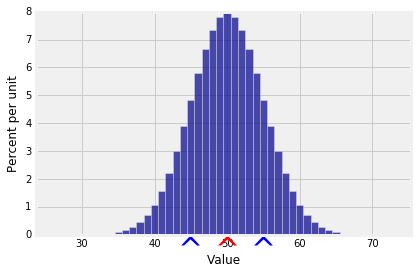Sums of IID Samples
Sums of IID Samples¶
After the dry, algebraic discussion of the previous section it is a relief to finally be able to compute some variances.
Let $X_1, X_2, \ldots X_n$ be random variables with sum $$ S_n = \sum_{i=1}^n X_i $$ The variance of the sum is
\begin{align*} Var(S_n) &= Cov(S_n, S_n) \\ &= \sum_{i=1}^n\sum_{j=1}^n Cov(X_i, X_j) ~~~~ \text{(bilinearity)} \\ &= \sum_{i=1}^n Var(X_i) + \mathop{\sum \sum}_{1 \le i \ne j \le n} Cov(X_i, X_j) \end{align*}We say that the variance of the sum is the sum of all the variances and all the covariances.
If $X_1, X_2 \ldots , X_n$ are independent, then all the covariance terms in the formula above are 0.
Therefore if $X_1, X_2, \ldots, X_n$ are independent then $$ Var(S_n) = \sum_{i=1}^n Var(X_i) $$
Thus for independent random variables $X_1, X_2, \ldots, X_n$, both the expectation and the variance add up nicely:
$$ E(S_n) = \sum_{i=1}^n E(X_i), ~~~~~~ Var(S_n) = \sum_{i=1}^n Var(X_i) $$When the random variables are i.i.d., this simplifies even further.
Sum of an IID Sample¶
Let $X_1, X_2, \ldots, X_n$ be i.i.d., each with mean $\mu$ and $SD$ $\sigma$. You can think of $X_1, X_2, \ldots, X_n$ as draws at random with replacement from a population, or the results of independent replications of the same experiment.
Let $S_n$ be the sample sum, as above. Then
$$ E(S_n) = n\mu ~~~~~~~~~~ Var(S_n) = n\sigma^2 ~~~~~~~~~~ SD(S_n) = \sqrt{n}\sigma $$This implies that as the sample size $n$ increases, the distribution of the sum $S_n$ shifts to the right and is more spread out.
Here is one of the most important applications of these results.
Variance of the Binomial¶
Let $X$ have the binomial $(n, p)$ distribution. We know that $$ X = \sum_{i=1}^n I_j $$ where $I_1, I_2, \ldots, I_n$ are i.i.d. indicators, each taking the value 1 with probability $p$. Each of these indicators has expectation $p$ and variance $pq = p(1-p)$. Therefore
$$ E(X) = np ~~~~~~~~~~ Var(X) = npq ~~~~~~~~~~ SD(X) = \sqrt{npq} $$For example, if $X$ is the number of heads in 100 tosses of a coin, then
$$ E(X) = 100 \times 0.5 = 50 ~~~~~~~~~~ SD(X) = \sqrt{100 \times 0.5 \times 0.5} = 5 $$Here is the distribution of $X$. You can see that there is almost no probability outside the range $E(X) \pm 3SD(X)$.
k = np.arange(25, 75, 1)
binom_probs = stats.binom.pmf(k, 100, 0.5)
binom_dist = Table().values(k).probability(binom_probs)
Plot(binom_dist, show_ev=True, show_sd=True)
